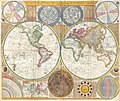ملف:1794 Samuel Dunn Wall Map of the World in Hemispheres - Geographicus - World2-dunn-1794.jpg

حجم هذه المعاينة: 712 × 600 بكسل. الأبعاد الأخرى: 285 × 240 بكسل | 570 × 480 بكسل | 912 × 768 بكسل | 1٬216 × 1٬024 بكسل | 2٬431 × 2٬048 بكسل | 6٬000 × 5٬054 بكسل.
الملف الأصلي (6٬000 × 5٬054 بكسل حجم الملف: 8٫92 ميجابايت، نوع MIME: image/jpeg)
| هذه صورة مختارة، وهذا يعني أن مجتمع ويكيبديا العربية اتفق على تصنيفها واحدة من أفضل الصور في ويكيبيديا العربية، وتضيف شيئاً هامّاً إلى مقالها. إذا كنت تملك صورة أخرى ذات جودة مشابهة، فلا تتردد في رفعها مستخدماً ترخيصاً حرّاً مناسباً، وإضافتها إلى مقال مناسب، ومن ثم ترشيحها. |
تاريخ الملف
اضغط على زمن/تاريخ لرؤية الملف كما بدا في هذا الزمن.
| زمن/تاريخ | صورة مصغرة | الأبعاد | مستخدم | تعليق | |
|---|---|---|---|---|---|
| حالي | 20:01، 1 يونيو 2012 |  | 6٬000 × 5٬054 (8٫92 ميجابايت) | Brandmeister~commonswiki | Reverted to version as of 04:17, 23 March 2011 |
| 16:15، 19 مايو 2012 |  | 6٬000 × 5٬054 (27٫38 ميجابايت) | Brandmeister~commonswiki | contrast | |
| 04:17، 23 مارس 2011 |  | 6٬000 × 5٬054 (8٫92 ميجابايت) | BotMultichillT | {{subst:User:Multichill/Geographicus |link=http://www.geographicus.com/P/AntiqueMap/World2-dunn-1794 |product_name=1794 Samuel Dunn Wall Map of the World in Hemispheres |map_title=A General Map of the World, or Terraqueouis Globe with all the New Discover |
استخدام الملف
ال6 صفحات التالية تستخدم هذا الملف:
الاستخدام العالمي للملف
الويكيات الأخرى التالية تستخدم هذا الملف:
- الاستخدام في alt.wikipedia.org
- الاستخدام في av.wikipedia.org
- الاستخدام في br.wiktionary.org
- الاستخدام في ckb.wikipedia.org
- الاستخدام في cv.wikipedia.org
- الاستخدام في de.wikipedia.org
- الاستخدام في en.wikipedia.org
- Early world maps
- History of cartography
- Southern Ocean
- Samuel Dunn (mathematician)
- Wikipedia:Featured picture candidates/1794 Samuel Dunn Map
- A General Map of the World, or Terraqueous Globe
- Wikipedia:Featured picture candidates/June-2012
- User:Cruickshanks/sandbox2
- Wikipedia:Featured picture candidates/March-2014
- Wikipedia:Featured picture candidates/1794 Samuel Dunn Wall Map of the World in Hemispheres - Geographicus - World2-dunn-1794.jpg (review)
- User:Setvina/be bold
- Portal:Maps
- User:Sarangem
- User:Jacobwilder427
- الاستخدام في en.wiktionary.org
- الاستخدام في eo.wikipedia.org
- الاستخدام في et.wikipedia.org
- الاستخدام في eu.wikipedia.org
- الاستخدام في fa.wikipedia.org
- ویکیپدیا:نگارههای برگزیده/نقشه
- ویکیپدیا:گزیدن نگاره برگزیده/ژوئن-۲۰۱۲
- نقشه ساموئل دان
- ویکیپدیا:گزیدن نگاره برگزیده/1794 Samuel Dunn Wall Map of the World in Hemispheres - Geographicus - World2-dunn-1794.jpg
- ویکیپدیا:نگاره روز/اکتبر ۲۰۱۲
- الگو:نر/2012-10-03
- الگو:نر محافظت شده/2012-10-03
- بحث کاربر:Alborzagros/بایگانی ۷
- الاستخدام في fr.wikipedia.org
- الاستخدام في fr.wikiversity.org
- الاستخدام في gl.wikipedia.org
- الاستخدام في hu.wikipedia.org
- الاستخدام في hy.wikipedia.org
- الاستخدام في id.wikipedia.org
- الاستخدام في it.wiktionary.org
- الاستخدام في kk.wikipedia.org
- الاستخدام في ko.wikipedia.org
- الاستخدام في lbe.wikipedia.org
- الاستخدام في lez.wikipedia.org
اعرض المزيد من الاستخدام العام لهذا الملف.

